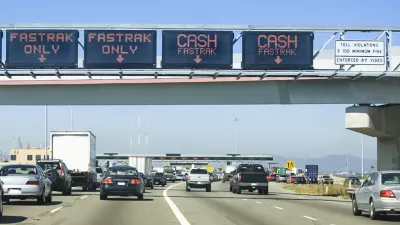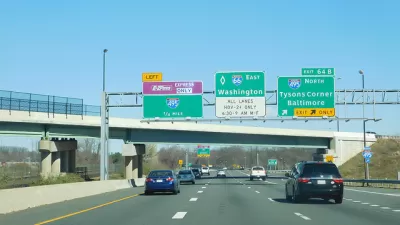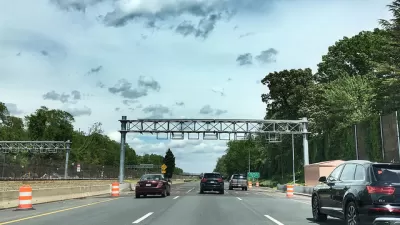Two things motorists detest: tolls and congestion. Tolls, if effectively applied, lessen congestion, but at a high cost to drivers. However, steep tolls also provide a political incentive to "fix the bottlenecks," as shown by the 66 Express Lanes.

Another lesson from what may be America's best example of roadway congestion pricing, where tolls topping $40 (one-way) do occur on occasion, particularly when the subway breaks down.
Max Smith, WTOP’s Northern Virginia transportation reporter, writes that construction has begun to add an additional lane "to ease a chokepoint that helps drive up toll prices on Interstate 66 inside the Capital Beltway...Those frequent traffic jams are a significant driver of the morning toll prices for solo drivers using the highway."
Unlike all other high occupancy tolls (HOT) lanes adjacent to general purpose (unpriced) lanes in the United States, all lanes on the 66 Express Lanes become HOT lanes during the peak hours in the peak direction, so motorists can't escape the congestion, nor the toll unless they carpool ride a motorcycle.
The operator of the 66 Express Lanes, the Virginia Department of Transportation (VDOT), may also be more politically sensitive to criticism than private operators, such as Transurban, an Australian company which built and operates the 495 and 95 Express Lanes in Virginia. VDOT has been attempting to reduce the tolls, without capping or refunding them, as some legislators demand, by tweaking the toll pricing algorithm.
Average tolls on 66 Express Lanes
While those $40+ tolls make headlines, they are not the norm. Smith reported on Aug. 20 that "[f]rom the time tolling began Dec. 4 through the end of June, the overall average paid by each toll payer each morning is now $8.39, with the average in the afternoon now at $5.21."
Tolls are higher in the morning than the afternoon largely due to the chokepoint at the Dulles Connector Road, where traffic can frequently slow...
Which brings us back to where we started, as this is the stretch that's being widened.
Smith also reported that the violation rate, i.e., motorists who don't have transponders (E-ZPass) and face penalties on top of tolls, is 13.5 percent.
While the 66 Express Lanes are unique due to the all-HOT Lane design, they are similar to other HOT lanes in that a large percentage of users are not paying tolls because these are, after all, carpool lanes. Unlike other HOT lanes, there is no toll-exemption for electric vehicles.
Overall, more vehicles paid to use the road in June with a regular E-ZPass or an E-ZPass Flex in toll paying mode (44.2 percent) than rode free with an E-ZPass Flex switched to HOV mode to indicate the driver had at least one other person with them in the car (42.3 percent).
Related 66 Express Lanes posts:
-
Capitalism at Work on an Interstate Highway, June 12, 2018
-
Popularity of Express Lanes Spreads Beyond Virginia, April 3, 2018
Hat tip to IBTTA Smart Brief.
FULL STORY: I-66 widening work on choke point that drives up tolls begins

Americans May Be Stuck — But Why?
Americans are moving a lot less than they once did, and that is a problem. While Yoni Applebaum, in his highly-publicized article Stuck, gets the reasons badly wrong, it's still important to ask: why are we moving so much less than before?

Using Old Oil and Gas Wells for Green Energy Storage
Penn State researchers have found that repurposing abandoned oil and gas wells for geothermal-assisted compressed-air energy storage can boost efficiency, reduce environmental risks, and support clean energy and job transitions.

Placekeeping: Setting a New Precedent for City Planners
How a preservation-based approach to redevelopment and urban design can prevent displacement and honor legacy communities.

San Francisco’s Muni Ridership Grew in 2024
The system saw its highest ridership since before the Covid-19 pandemic, but faces a severe budget shortage in the coming year.

Colorado Lawmakers Move to Protect BRT Funding
In the face of potential federal funding cuts, CDOT leaders reasserted their commitment to planned bus rapid transit projects.

Safe Streets Funding in Jeopardy
The Trump administration is specifically targeting bike infrastructure and other road safety projects in its funding cuts.
Urban Design for Planners 1: Software Tools
This six-course series explores essential urban design concepts using open source software and equips planners with the tools they need to participate fully in the urban design process.
Planning for Universal Design
Learn the tools for implementing Universal Design in planning regulations.
Heyer Gruel & Associates PA
City of Moreno Valley
Institute for Housing and Urban Development Studies (IHS)
City of Grandview
Harvard GSD Executive Education
Salt Lake City
NYU Wagner Graduate School of Public Service
City of Cambridge, Maryland




























